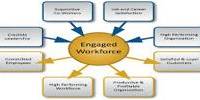Introduction:
Reward Strategy defines the intention of organization how its reward policies and processes should be developed to business requirements. All of the tools available to the employer that may be used to attract, motivate and retain employees. Total rewards include everything the employee perceives to be of value resulting from the employment relationship.
Reward is one of the key levers available to an organization to influence the behavior, motivation and the commitment of its staff. In fact the overall approach to reward sends strong messages to all employees about what is important to the business. There is no one “best practice” in terms of reward, only a best practice for the specific organization given the variables impacting on it. Some of these variables are specific to the organization, others relative to the industry while others are national and even international initiatives (particularly if the company is a multinational).
Critical elements/variables to be considered before developing a reward strategy
- Understanding the organization, its position in its life cycle, strategy, critical success factors and culture.
- Understanding the workforce and its demographics.
- Knowing the perceptions and values of stakeholders relative to remuneration.
- Understanding the market in which you compete for skills, the areas of shortage and demand for scarce talent.
- Understanding the environment in which the company operates.
Although rewards must be broadly aligned with the vision and strategic direction of the company, the realities of the situation as mentioned above, must be taken into account to ensure corporate strategy is successful transformed into a viable operational plan. Most strategies fail through poor implementation. An effective reward strategy, balances strategic and operational goals, ensuring short term actions don’t negate long term opportunities and that the organization can attract, retain and motivate the quality of people it needs – people with the necessary skills, experience (and/or potential to develop these skills) to achieve its goals.
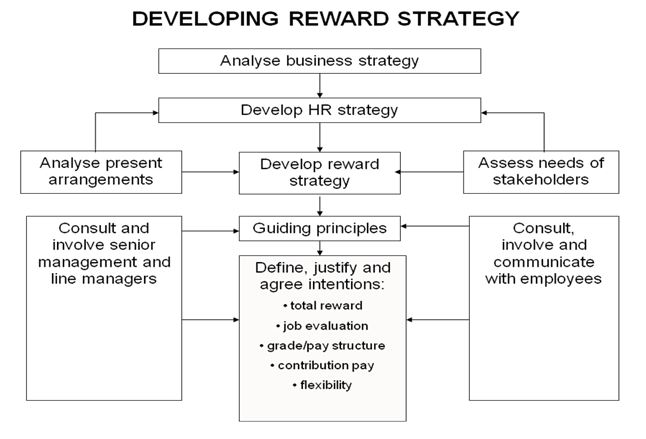
Figure- 1 Developing Reward Strategy
Components of a reward strategy include:
Paying for Performance
A remuneration strategy should ensure significant differentiation in reward between top performing employees and others, and a remuneration mix that is customized in a way that recognizes the preferences of different employee groups. The defensibility of pay is always enhanced within the company and without, when linked to performance and as such should be integral in any reward policy. Rewards perceived as an entitlement regardless of performance are neither cost effective nor motivational. Differentials in pay levels, increments and incentives favoring the good performers will drive positive behavior.
Guaranteed pay
Guaranteed pay should be driven by market competitiveness (scarcity), internal equity, and individual performance. Whereas for example, competent performance could be linked to median rates, upper quartile guaranteed package rates should be reserved for outstanding performers rather than those with long service.
Short term incentives
Variable pay is an essential component of any reward strategy. Not only are they a mechanism for recognizing work well done, they can ensure highly competitive earnings relative to the market. Whereas fixed pay levels inflate payroll and cannot easily be reduced, variable pay is more flexible and can be aligned to possible fluctuating individual and company performance and budgetary constraints. The combination of reasonably competitive guaranteed pay, (as opposed to highly competitive), and an aggressive incentive scheme will motivate good performers and ensure optimum payroll spend.
Long term incentives
Executives and management should have a balance between short and long term reward as they need to focus on both operational and strategic issues .The alignment of management’s and the company’s medium to long term interests remains the underlying value proposition for long term incentives. There has however been some fall-off in the practice of offering of share options due to tax and cash flow implications arising from new legislation. This has given rise to other options such as endowment policies, phantom shares, banked bonuses etc.
Performance Management
Reward linked to performance remains an effective and defensible strategy, an important consideration with the spotlight on executive pay and good governance. In this respect a key success factor is to create a performance – focused culture and a defensible credible performance measurement process. The challenge is to develop an environment where people know and understand the purpose and value of their work. Yet in many instances companies pay lip service to the concept and formal performance management programmers are not always a success: “Performance management is one of the tools for creating a more efficient and profitable business that has often historically been viewed as ineffective, highly political, and a time-consuming chore”. Yet there is not a single company that would not welcome a system that can deliver:
- Clearly articulated goals so employees and managers understand expectations.
- Valid information on just how well they are doing.
- Fair and equitable reward linked to performance.
- Tactful and just-in-time feedback on areas in need of improvement.
- Identification of opportunities for personal development.
To be effective the management of performance needs to be a formalized process with performance measures updated at least annually, formal reviews held regularly and development plans agreed and monitored. This requires senior management’s commitment and active participation.
Personal Development
A key reward broader than remuneration is the extent to which employees can grow in the job – the extent to which their skills are enhanced in order to qualify for greater job challenges. Practice has shown that personal development, work challenge and opportunities for career progression are all motivators that play a major role in the attraction and retention of staff.
Reward management is concerned with the formulation and implementation of strategies and policies that aim to reward people fairly, equitably and consistently in accordance with their value to the organization. It deals with the design, implementation and maintenance of reward processes and practices that are geared to the improvement of organizational, team and individual performance. Reward Strategy sits at the heart of all reward activity. It is essential to ensure your people understand and appreciate their package in its entirety, not just the cash elements. When you deliver all of the elements of Total Reward employees will experience increased satisfaction with the package, increased engagement with your business and its objectives and ultimately, as can be proven by research in a number of blue chip organizations, improved customer service and higher levels of business performance. Total Reward is your people proposition, joining as it does all the elements your employees need to have in order to engage with their job and your business. It can be used as the yardstick for measuring the effectiveness of most HR activity.
AIMS OF REWARD MANAGEMENT
- Create total reward processes that are based on beliefs about what the organization values and want to provide rewards for.
- Reward people for the value they create.
- Align reward practices with both business goals and employee values.
- Reward the right things to convey the right message about what is important in terms of behaviours and outcomes.
- Facilitate the attraction and retention of the skilled and competent people the organization needs, thus winning the war for talent.
- Help in the process of motivating people and gaining their commitment and engagement.
- Support the development of a performance culture.
- Develop a positive employment relationship and psychological contract.
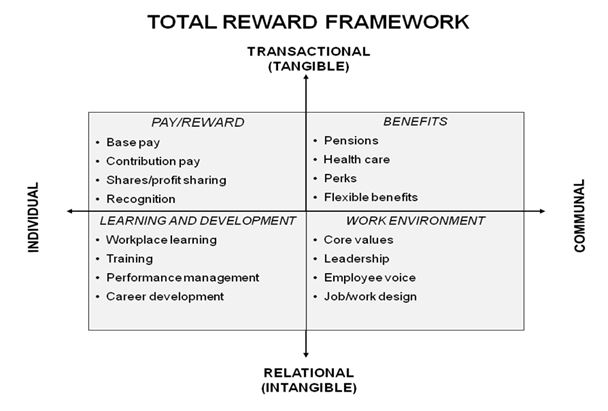
Figure- 2 Total Reward framework
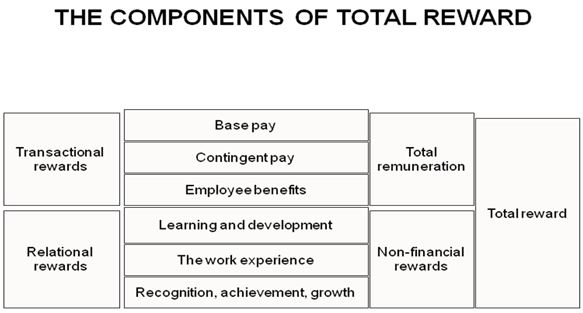
Elements of Total Rewards
There are five elements of total rewards, each of which includes programs, practices, elements and dimensions that collectively define an organization’s strategy to attract, motivate and retain employees. These elements are:
- Compensation
- Benefits
- Work-Life
- Performance and Recognition
- Development and Career Opportunities
The elements represent the “tool kit” from which an organization chooses to offer and align a value proposition that creates value for both the organization and the employee. An effective total rewards strategy results in satisfied, engaged and productive employees, who in turn create desired business performance and results.
The elements, as World at Work has defined them, are not mutually exclusive and are not intended to represent the ways that companies organize or deploy programs and elements within them. For instance, performance management may be compensation-function- driven activity or may be decentralized in line organizations; it can be managed formally or informally. Likewise, recognition could be considered an element of compensation, benefits and work-life.
Compensation
Pay provided by an employer to an employee for services rendered (i.e., time, effort and skill). Compensation comprises four core elements:
- Fixed pay — Also known as “base pay,” fixed pay is nondiscretionary compensation that does not vary according to performance or results achieved. It usually is determined by the organization’s pay philosophy and structure.
- Variable pay — Also known as “pay at risk,” variable pay changes directly with the level of performance or results achieved. It is a one-time payment that must be re-established and re-earned each performance period.
- Short-term incentive pay – A form of variable pay, short-term incentive pay is designed to focus and reward performance over a period of one-year or less.
Long-term incentive pay — A form of variable pay, long-term incentive pay is designed to focus and reward performance over a period longer than one year. Typical forms include stock options, restricted stock, performance shares, performance units and cash.
Benefits
Programs an employer uses to supplement the cash compensation that employees receive. These programs are designed to protect the employee and his or her family from financial risks and can be categorized into the following three elements:
- Social Insurance
- Unemployment
- Workers’ compensation
- Social Security
- Disability (occupational)
- Group Insurance
- Medical
- Dental
- Vision
- Prescription drug
- Mental health
- Life insurance
- AD&D insurance
- Disability
- Retirement
- Savings
- Pay for Time Not Worked — These programs is designed to protect the employee’s income flow when not actively engaged at work.
- At work (breaks, clean-up time, uniform changing time)
- Away from work (vacation, company holidays, personal days).
Work-Life
A specific set of organizational practices, policies, programs, plus a philosophy, which actively supports efforts to help employees achieve success at both work and home. There are seven major categories of organizational support for work-life effectiveness in the workplace. These categories encompass compensation, benefits and other HR programs. In combination, they address the key intersections of the worker, his or her family, the community and the workplace. The seven major categories are:
- Workplace flexibility
- Paid and unpaid time off
- Health and well-being
- Caring for dependents
- Financial support
- Community involvement
- Management involvement/culture change interventions.
Performance and Recognition
Performance
A key component of organizational success, alignment of organizational, team and individual performance is assessed in order to understand what was accomplished, and how it was accomplished. Performance involves the alignment of organizational, team and individual effort toward the achievement of business goals and organizational success.
- Performance planning – is a process whereby expectations are established linking individual with team and organizational goals. Care is taken to ensure goals at all levels are aligned and there is clear line of sight from performance expectations of individual employees all the way up to organizational objectives and strategies set at the highest levels of the organization.
- Performance – is the manner of demonstrating a skill or capacity.
- Performance feedback – communicates how well people do a job or task compared to expectations, performance standards and goals. Performance feedback can motivate employees to improve performance.
Recognition
Acknowledges or gives special attention to employee actions, efforts, behavior or performance. It meets an intrinsic psychological need for appreciation for one’s efforts and can support business strategy by reinforcing certain behaviors (e.g., extraordinary accomplishments) that contribute to organizational success. Whether formal or informal, recognition programs acknowledge employee contributions immediately after the fact, usually without predetermined goals or performance levels that the employee is expected to achieve. Awards can be cash or non-cash (e.g., verbal recognition, trophies, certificates, plaques, dinners, tickets, etc.).
Development and Career Opportunities
Development
A set of learning experiences designed to enhance employees’ applied skills and competencies; development engages employees to perform better and leaders to advance their organizations’ people strategies.
Career Opportunities
A plan for an employee to advance their own career goals and may include advancement into a more responsible position in an organization. The organization supports career opportunities internally so that talented employees are deployed in positions that enable them to deliver their greatest value to their organization.
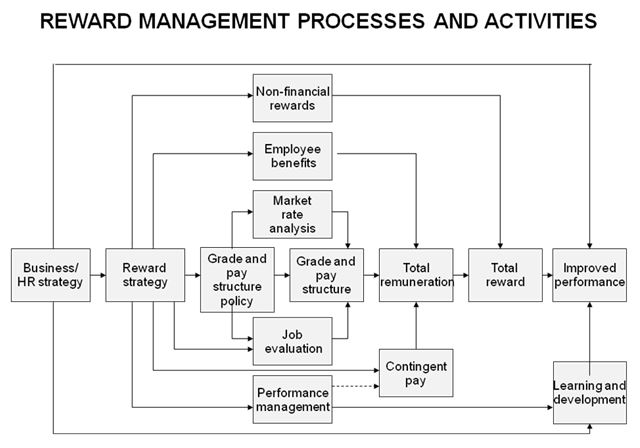
Figure-3 Reward System Model
Types of Employee Reward
There are several ways to classify rewards they are discussed below-
Intrinsic Rewards
Intrinsic rewards are the personal satisfaction one gets from the job itself. These are self- initiated rewards, such as having in one’s work, having a feeling of accomplishment or being part of work team. Achievements feeling of the accomplishment, informal recognition, job satisfaction, personal growth, status etc. are the example of these rewards.
Extrinsic Rewards
Extrinsic Rewards, on the other hand, include money, promotions and benefits. These are directly provided by the organization for performing certain jobs. The firm directly controlled these rewards. Formal recognition, fringe benefits, incentive, pay, promotions are the example of these rewards.
Financial Rewards
Rewards may or may not enhance the employee’s financial well being. If they do they can do this directly, for instance through wages, bonuses or profit sharing, or directly through employer-subsidized benefits such as retirement plans, paid vacations, paid sick leaves purchase discounts.
Non- Financial Rewards
Non -Financial Rewards cover some of desirable extras are potentially at the disposal of the organization. Insurance, sick leave, casual leave, working condition, workplace environment etc. are treated these type of non financial benefits and these benefits may have an impact to improve an employee’s psychological condition.
Performance Based Rewards
Performance based are exemplified by the use of commissions, piece work pay plans, incentive systems, group bonuses, merit pay or other forms of pay for performance plans.
Membership- Based Rewards
Membership based rewards cost of living increase, benefits and salary increases attributable to labor conditions, seniority or time in rank, credentials( such as a college degree or a graduate specials degree) a specialized skill or future potentials. The key point here is that membership based rewards are generally extended regardless of an individual’s group’s or organization’s performance.
An Integrated between Total Rewards Strategy and Personnel Strategy
Culture
Culture consists of the collective attitudes and behaviors that influence how individuals behave. Culture determines how and why a company operates in the way it does. Typically, it is comprised of a set of often unspoken expectations, behavioral norms and performance standards to which the organization has become accustomed. Culture change is difficult to achieve because it involves changing attitudes and behaviors by altering their fundamental beliefs and values. Organizational culture is subject to internal and external influences; thus, culture is depicted as a contextual element of the total rewards model, overlapping within and outside the organization.
Environment
Environment is the total cluster of observable physical, psychological and behavioral elements in the workplace. It is the tangible manifestation of organizational culture. Environment sets the tone, as everyone who enters the workplace reacts to it, either consciously or unconsciously. Because they are directly observable and often measurable, specific elements of the environment can be deliberately manipulated or changed. The external environment in which an organization operates can influence the internal environment; thus, environment is depicted as a contextual element of the total rewards model, overlapping within and outside the organization.
Attraction
The ability an organization has to draw the right kind of talent necessary to achieve organizational success. Attraction of an adequate (and perpetual) supply of qualified talent is essential for the organization’s survival, and it is one of the key planks of business strategy. One way an organization can address this issue is to determine which “attractors” within the total rewards programs brings the kind of talent that will drive organizational success. A deliberate strategy to attract the quantity and quality of employees needed to drive organizational success is one of the key planks of business strategy.
Retention
An organization’s ability to keep employees who are valued contributors to organizational success for as long as is mutually beneficial. Desired talent can be kept on-staff by using a dynamic blend of elements from the total rewards package as employees move through their career lifecycles. However, not all retention is desirable, which is why a formal retention strategy with appropriate steps is essential.
Motivation
The ability to cause employees to behave in a way that achieves the highest performance levels. Motivation is comprised of two types:
- Intrinsic Motivation — Linked to factors that include an employee’s sense of achievement, respect for the whole person, trust, appropriate advancement opportunities and others, intrinsic motivation consistently results in higher performance levels.
- Extrinsic Motivation — Extrinsic motivation is most frequently associated with rewards that are tangible such as pay.
There also are defined levels of intensity with regard to motivation:
- Satisfaction — how much I like things here
- Commitment — how much I want to be here
- Engagement — how much I will actually do to improve business results.
Another key plank of the business strategy, motivation can drive organizational success.
Conclusion
In above the discussion it will be cleared that, effective financial rewards strategies come from a proper allocation of a company’s investment in its compensation and benefit plans. Most companies limit their ability to create sustainable results in their business in part because they limit the range of compensation strategies they employ to impact the behavior of key individuals and teams. From a practical standpoint, employees are expecting two things from their financial rewards program: confidence in lifestyle and participation in value creation. Confidence in lifestyle is achieved primarily by having sustainable cash flow needs met and by securing one’s financial environment. These are fulfilled primarily through a combination of salary, short-term incentives (annual bonus) and employee benefits (group insurance, cafeteria plans, supplemental insurance.
On the other hand, participation in value creation has primarily to do with wealth building opportunities. The levels of reward that vary, depending on the contribution of the individual, team and operating company to overall business success. Organization set an effective reward strategy based on measuring the job and its accountabilities to recognising the person and the contribution they make to the business.


